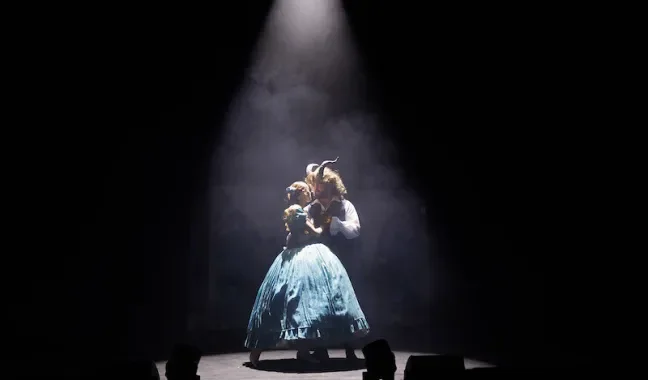Container, New Diorama Theatre Review
Container production image. Photo by Camilla Greenwell
Written by Greta for Theatre & Tonic
Disclaimer: Gifted tickets in exchange for an honest review
This is not the review I would have liked to write. Ironically enough, the reason why is one of the instigators of Container, the piece I’m setting out to write about. Alan Fielden, writer and director of the show, and one of its five performers, writes about Container’s premise: “I’m going about my day. I scroll my phone, and in my hand I see a missile destroy an apartment block in a distant city. I see someone rushing their relative to the hospital. I see a person talking through their experience of torture. I wonder what I can do with this grief and horror. If it can be challenged toward anything of use. (…) Container is about reaching breaking point. (…) What happens when the container can’t bear its contents, when it cracks open, or overflows”. Today, I found myself reflecting on the perpetual state of burnout that the recent years have been inflicting on many of us; that the state of the world, its deep injustices and inequalities, and all the violence and suffering we feel powerless about, are slowly eroding us. As the performers of Container put it, I’m finding it hard to think. It is indeed hard to function throughout it all, and I wonder what this review could look like if I had my full mental and emotional capacity, unburdened, to dedicate to it. The only thing I can do, now, is giving it my best shot within the unthinkable circumstances that Container expresses so well.
Container is a quintet, more than a five-hander. Through a veritable orchestra of five deviser-performers, we experience the polyphony of simultaneous narratives and sounds, as the collective’s voices talk, whisper, scream and sing – sometimes in unison, sometimes stacked against each other, sometimes overlapping in a vocal dance of incredible precision. The script is used as a sound score to explore the overwhelm of passively experiencing a multiplying number of concurrent horrors and crises, along with the love and care still persisting underneath it all.
The use of polyphony creates a rhythm and musicality that lends itself well to the incorporation of singing and live music, and eludes linear narratives. Instead of being presented with a story, we are bombarded with questions (“do you usually cry at funerals?”), greetings (“welcome to my house!”) pleas (“please, look at my taxidermy frogs!”), declarations and statements of various nature. The information, from the mundane to the catastrophic, floods and envelops us. It also allows for themes and scenarios to be explored simultaneously with different perspectives and languages, to be reprised and rephrased, always painting complex images and eschewing simplistic explanations.
Additionally, Container is constantly making us aware of our presence in the theatre and our own engagement with the show. The constant overlap of voices and text invites us to choose whether to tune into one performer or the other at any time, giving us agency in how we experience the show. The performers address us directly, and the house lights are kept on for whole sections of the show; Container is in direct conversation with us, asking us to stay present, to look at the world and ourselves.
The impressive contrapuntal work of the collective is interposed by three short scenes of more straightforward storytelling. In these sections, two miniature mice are carefully placed in the middle of the stage, while one performer narrates a seemingly unrelated story. The infinite different scenarios I am sure were being imagined by each member of the audience made me reflect on how instinctual the process of meaning making is: looking at two small dressed-up mice without being given further explanations, we are left with the freedom to imagine whatever we want, to project any kind of meaning - strictly logical to wildly fantastical - on what’s happening. I am reminded of Complete Works by Forced Entertainment, a series of performances in which Shakespeare plays are narrated using everyday objects, such as ketchup bottles and saltshakers, to represent its characters. Forced Entertainment’s Artistic Director Tim Etchells describes the process of projecting meaning on objects as a “low-level transformative magic”. This is what happens in Container: when we are left with two mice, a story, and a world of possibilities as to how it all is related, and how (or if) it might make sense together, we are invited to participate in the creation of meaning and to transform it into something uniquely ours.
Container is an absorbing, brave and honest piece that intersects narratives about migration, violence and the “homeless, desperate, displaced”. References to bodies breaking down, society burning, and people dying, make the underlying themes of overwhelm and devastation resonate with ferocity, reaching a climax when the words “I can’t stand it, I can’t take it anymore” are repeated over and over in a loop.
Jemima Young, Clara Potter-Sweet, Ben Kulvichit, Tim Cape and Alan Fielden are a remarkable, precisely choreographed chorus which, ultimately, says a lot about the beauty and humanity that can be found in togetherness; each performer retains their unique storytelling style, while actively listening to each other and being in tune with the group, creating an harmony that is moving to witness. The show, tapping into individual experiences as well as a sense of universality, at moments achieves a sense of sublime; the pictures painted by the carefully chosen, wide-ranging text reaches a level of vastness that is both striking and challenging to contemplate.
At New Diorama Theatre until 12 April 2025
★★★★★













